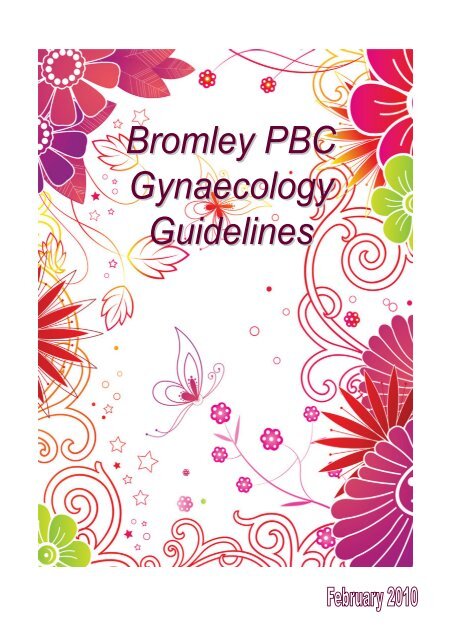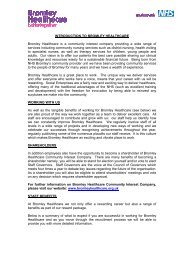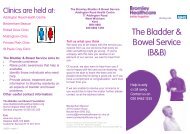Gynaecology Guidelines - Bromley Healthcare
Gynaecology Guidelines - Bromley Healthcare
Gynaecology Guidelines - Bromley Healthcare
Create successful ePaper yourself
Turn your PDF publications into a flip-book with our unique Google optimized e-Paper software.
<strong>Bromley</strong> PBC<strong>Gynaecology</strong><strong>Guidelines</strong><strong>Bromley</strong> PBC<strong>Gynaecology</strong>Version 13 : 24.10.09Page1
<strong>Bromley</strong> PBC <strong>Gynaecology</strong>Dear ColleagueFebruary 2010We are delighted to be able to circulate copies of the <strong>Gynaecology</strong> <strong>Guidelines</strong> that havebeen developed by GPs for GPs.Please share them with your colleagues, give them a go and let us know what you think.<strong>Guidelines</strong> can go out of date but very soon these will be made available on the new<strong>Bromley</strong> PbC website and will be updated on a regular basis.Many of you will know that our starting point was trying to understand the high and variablerates of gynaecological referrals from practices to secondary care. Through our discussionswith practices it became clear that developing a set of easy to follow guidelines would beincredibly useful. The key messages that came out of all the discussions were:• Recognising that consultant gynaecologists are surgeons and they should be seeingpatients who might need an operation. Hospital outpatient clinics are expensive.• Many GPs lack confidence in their own knowledge or skills and believe that their patientsdemand a consultant opinion. In some cases this will be true, but many patients wouldprefer to be managed by a GP that they trust and who offers greater accessibility andcontinuity of care.• Patients cannot demand to see a particular specialist on the NHS. Community clinics ofthe highest standard are a logical next step for patients who need more than their GPbut who do not immediately require a surgeon’s opinion.• If patients are to be referred to the right person, in the right place and at the right time,GPs need to be supported to think clearly about their referrals and to communicate moreeffectively with their patients.• Costs would be reduced and patient care enhanced if there was a shared understandingof the management of common gynaecological conditions and a wider range of optionsfor investigation and treatment patients outside of the hospital outpatient clinic.We are currently working with the PCT to establish a community <strong>Gynaecology</strong> ‘One Stop’Service for women in <strong>Bromley</strong> and will keep you informed of developments.Most importantly, a very big thank you to James Heathcote who led the working group andto his team Nikki Payne, William Okonji & Seye Sodipe and of course the practices involvedin the discussions.With very best wishes,Yours sincerelyNeil Francis, Andrew Parson, Ruchira Paranjape, Alan FishtalChief Executive Clin Lead <strong>Bromley</strong> Clin Lead Orpington Clin Lead Unity
<strong>Bromley</strong> PBC<strong>Gynaecology</strong>IntroductionWelcome to the <strong>Bromley</strong> PBC Gynae management project. We would like to introduceyou to some easy to follow, evidence based and locally referenced care pathways thathave been designed to help all GPs to deliver a first class service to their patients.To make the most of these guidelines, please spend a few minutes looking at them to seewhat is there and how they work. You will soon see that .....The next page is a list of the pathways included.Next comes a page that summarises the key points in a full gynae history. This is onlyhere as an aide memoire and if it doesn’t help you, please skip past it.Thereafter there is a common format of one page algorithm and one page notes.All of the algorithms read from top to bottom with as few boxes and tricks in them aspossible. The small boxed numbers refer to foot notes on the second page.Also on the second page, you will find Key Messages and Resources (usually on theweb) and these will help you find the national guidelines on which these pathwaysare based, patient information and (occasionally) images to help you.◘These are guidelines not rulesFollow your clinical instincts◘At the end of the guidelines, you will then find information on Two Week cancer referralsand the answers to some Frequently Asked Questions.If you have any corrections, questions or ideas that could improve them, please let usknow by e-mailing Janet.Edmonds@bromleypct.nhs.uk .The next stage in this project will be to expand the options available to you whenmanaging your patients by making existing services more accessible or commissioningnew services. As and when we are able to do this, we shall update the guidelines.Janet Edmonds, James Heathcote, William Okonje,Nikki Payne, Seye Sodipe[ <strong>Bromley</strong> PCT Gynae Project team members ]<strong>Bromley</strong> PBC<strong>Gynaecology</strong>Version 13 : 24.10.09Page1
Gynae History1 presenting problem:Any possibility of pregnancy?Exclude cancer / STD / ectopic2 periods:( take an age-relevant history )LMP - Last menstrual periodK - Cycle length and frequencyHow heavy is the bleeding?IMB - Inter-menstrual bleeding?PCB - Postcoital bleeding?Age of menarche/menopause?PMB - Postmenopausal bleeding?3 discharge:Colour / smell / amountDurationItch / Rash?Symptoms in partner?4 pain:Duration, type, radiationPrecipitation or relief?Relation to menstrual cycle?Dyspareunia - superficial / deep?5 bladder symptoms:Dysuria / frequency / bloodHesitancy / stranguryStress or urge incontinence?6 pregnancy:Pregnancies (G) and births (P)Problems in pregnancy or labourMiscarriage / TOPs / subfertility7 contraception:Contraceptive method chosenUnprotected SI / pregnancy?Why? – was last period normal?Method required?Potential contraindications8 sex & relationships:Orientation and sexually active?In a relationship at the moment?"How are things between you?"9 infection:Past history of infection or PID?Any known contact with STD?Higher risk = age < 25years or... new partner in past 12 months10 general health:Bowel problems?Smoking/alcohol/drugs (esp iv usage)Other medical conditions?Drug historyGynaecological operations?Date and result of last cervical smear<strong>Bromley</strong> PBC<strong>Gynaecology</strong>Version 13 : 24.10.09Page2
ContentsGynae History Page 2Continence problems Pages 4-5Problem Periods (Heavy Menstrual Bleeding) Pages 6-7Polycystic Ovarian SyndromePart 1 : Diagnosis Pages 8-9Polycystic Ovarian SyndromePart 2 : Treatment Pages 10-11Postmenopausal Bleeding Pages 12-13Prolapse Pages 14-15Pruritus Vulvae Pages 16-17Vaginal infections Pages 18-19Benign cervical problems Pages 20-21Simple Ovarian Cysts Pages 22-23South East London Cancer Networkinformation to support <strong>Gynaecology</strong> referrals Pages 24Frequently asked questions Pages 25-27Dept of GUM/HIV Services Pages 28Enhanced Sexual Health Services Page 29Continence Service Page 30<strong>Bromley</strong> PBC<strong>Gynaecology</strong>Version 13 : 24.10.09Page3
Continence problemsWoman presents withbladder symptomsTake history to definebladder problem1Examine abdomen, inspectvulva and consider PVexam for pelvic floormuscle tone2Dipstick urinalysis+/- MSU3Refer ContinenceClinic and arrangefollow up4URGE= a sudden compelling desireto urinate that is difficult todeferSTRESS= involuntary urine leakageon effort, exertion, sneezingor coughingIf no better after 6 weeks, try......1st line: immediate release oxybutynin2nd line: Alternative antimuscarinic orlong acting oxybutyninIf post-menopausal, considerintravaginal oestragensRefer Urology if not better5If no better after 3 monthsof pelvic floor muscletraining, refer Gynae 6<strong>Bromley</strong> PBC<strong>Gynaecology</strong>Version 13 : 24.10.09Page4
Continence problemsKey messages:• Female continence problems include stress and urge incontinence and incomplete bladderemptying.• All of the above can be referred to the continence clinic for further management, but womenwith obvious prolapse or haematuria should be referred elsewhere (see below).Foot notes:1. Incontinence - if and when it happensBladder symptoms - hesitancy or voiding problems, prolapse, urgency, frequency andnocturia, dysuria and blood in urineMedical, occupation and drug history - treatable causes, eg lifting, cough or constipationO&G history - menopause status, big babies or difficult labours2. Refer, investigate or treat any abdominal mass (tumour, fibroids, constipation, bladder),atrophic vaginitis or prolapse (see prolapse pathway, pages 18-19). Arrange ultrasoundscan and refer gynae if the bladder is still palpable after voiding.NICE recommends a PV exam to assess pelvic floor muscle tone before starting pelvic floor muscletraining, but there is only low level evidence for this (see debate on link below)http://www.continence-uk.com/journal/downloads/0102_debate.pdf3. Send MSU if dipstick +ve or symptoms suggest UTI. Refer all women aged > 50 withmicroscopic haematuria to Urology. Refer women aged > 40 with recurrent or persisting UTIassociated with haematuria.4. The <strong>Bromley</strong> PCT Continence Service, 77 Addington Road, West Wickham, Kent BR49BG offers 16 clinics a month across Mottingham, Princes Plain, Penge, St Pauls Cray,Orpington & Addington Road will assess women with a full range of continence issues andrefer onwards if needed. Tel: 0208 462 1255.5. Start with oybutynin 5mg bd or tds (2.5 mg bd in elderly). If oxybutynin isn’t tolerated, tryany of the following: darifenacin, solifenacin, tolterodine, trospium or SR/patches ofoxybutynin - there is little to choose between then in terms of cost.Estriol [ortho-gynest] 0.5mg pessary (x15) or 0.01% cream (80g) apply 1 pessary orapplicatorful every evening for 2 weeks, then twice a week and reassess every 3-6 months.6. Refer <strong>Gynaecology</strong> unless there is a history of past bladder surgery, radiotherapy orcomplex pelvic surgery - in which case, refer Urology.Resources:For GPshttp://www.nice.org.uk/Guidance/CG40/NiceGuidance/pdf/Englishhttp://www.nice.org.uk/nicemedia/pdf/word/CG40quickrefguide1006.pdfFor patientswww.nice.org.uk/CG040publicinfoBladder diary: http://kidney.niddk.nih.gov/kudiseases/pubs/diary/index.htmhttp://www.patient.co.uk/ includes the following titles: Incontinence,Incontinence - Picture Summary, Urinary Incontinence, Stress Incontinence,Pelvic Floor Exercises, Incontinence / Bladder Chartand Urge Incontinence<strong>Bromley</strong> PBC<strong>Gynaecology</strong>Version 13 : 24.10.09Page5
Problem Periods 1Patient presents withHeavy Menstrual BleedingIs there Inter Menstrual orPost Coital Bleeding 2NOOrder Full Blood Count forALL women with HMB3YESInvestigateor referOffer abdominal andpelvic examination[+cervical smear if due]4Is abdominal and pelvicexamination needed?NO4YESIs theexaminationnormal?YESNO or(or not sure)Arrange pelvicultrasoundscan 5Offer treatment. Review and consider2nd line option. Safety net•Mirena IUS (* - see below)NB - take care to examine the patient firstIs ultrasound scanNORMAL oronly fibroids of 6 months**- stop if no improvement after 3 cyclesIf notsettled6, 7YESReferNOAge >45 : refer for endometrial biopsyAge
Problem Periods = Heavy Menstrual Bleeding[ based on NICE guideline CG44 ]Key messages:• HMB is not itself associated with significant mortality but a hysterectomy is a majoroperation, associated with significant complications in a minority of cases• In the early 1990s, at least 60% of women with HMB went on to have a hysterectomy butthis number is now decreasing rapidly• Treatment for uncomplicated HMB can safely be started in primary care without carrying outa physical examination or any complicated investigations• All women with HMB should have an FBC but other tests (ferritin, thyroid function, hormonelevels) are not routinely indicatedFoot notes:1. Heavy Menstrual Bleeding = excessive menstrual blood loss which interferes with the woman’sphysical, emotional, social and material quality of life and which can occur alone or incombination with other symptoms.2. A history of intermenstrual or postcoital bleeding, pelvic pain and/or pressure symptoms needsexplaining. Consider (but don’t assume) breakthrough bleeding or ectropion for youngerwomen on the pill and physical examination, ultrasound and/or referral for older women.3. Ferritin, thyroid function and hormone levels are not routinely indicated (NICE recommendation)4. If the history suggests HMB without structural or histological abnormality, pharmaceuticaltreatment can be started without carrying out a physical examination or other investigations.5. Specify ‘pelvic’ ultrasound. There is no need for a routine abdominal scan6. NICE guidance suggests that treatments should be considered in the following order:• Mirena IUS provided >12months use is anticipated (NB examine the patient first)• tranexamic acid (500mg 2 tds for up to 4 days) OR mefenamic acid [500mg tds from day 1] ornaproxen [500mg stat then 250mg tds-qds prn] OR mid dose combined oral contraceptives (egOvranette)• norethisterone (15mg od from days 5 to 26 of the menstrual cycle) or injected long-actingprogestogens (off license use of Implanon or [for 45 if treatment is ineffective.Resources:For GPsFor patientsNICE quick reference guide: http://www.nice.org.uk/CG044quickrefguidehttp://www.nice.org.uk/nicemedia/pdf/HMBUNGv9Sept08.pdfhttp://www.patient.co.uk/DisplayConcepts.asp?WordId=menorrhagia&MaxResults=50&x=17&y=14www.doctoronline.nhs.uk<strong>Bromley</strong> PBC<strong>Gynaecology</strong>Version 13 : 24.10.09Page7
Polycystic Ovarian SyndromePart 1 : DiagnosisWoman presents with possible PCOSConfirm specific history and signs• Infertility (73%)• Infrequent periods (66%)• Obesity (35-60%)• Hirsutism / acne (48%)1Ask for family history2Check drug history3Order testsFSH, LH, prolactin (if periods infrequent),TSH and Free Androgen Index(+ f.lipids and f.glucose if obese)Pelvic ultrasound4Diagnosisneeds2 of 3- Infrequent ovulation- Hyperandrogenism- Polycystic ovarieson ultrasound scan5Is PCOS diagnosis confirmed?6YESNOFollow secondPCOS guidelineReassure and treat anypresenting symptoms<strong>Bromley</strong> PBC<strong>Gynaecology</strong>Version 13 : 24.10.09Page8
Polycystic Ovarian SyndromePart 1 : DiagnosisKey messages:• PCOS is diagnosed on the basis of two out three of:• a) infrequent ovulation,• b) hyperandrogenism• c) polycystic ovaries on ultrasound scan• 22-33% of women have polycystic ovaries alone and have normal fertilityFoot notes:1. Take menstrual history and examine for BMI, hirsutism, acne, male pattern hair loss oracanthosis nigricans (hyperkeratosis and grey-brown pigmentation in axillae, neck,perineum, or extensor surfaces of the elbows and knuckles).2. A positive family history of PCOS and/or type 2 diabetes raises a woman’s risk of PCOS3. Steroids, phenytoin, minoxidil, metoclopramide and other less commonly used drugs can allcause hirsutism http://www.turner-white.com/memberfile.php?PubCode=hp_oct08_androgenism.pdf .4. LH may be moderately elevated in PCOSFSH should be normal in PCOSTSH and prolactin to rule out other causes for amenorrhoeaFree Androgen Index [= testosterone/SHBG] is more useful than serum testosteroneCheck f.glucose and f.lipids if obese to save having to do them later!5. Infrequent periods = a cycle of >35 days (ie less than 9 periods a year).Polycystic ovaries = 12 or more follicles in each ovary of 2–9 mm diameter &/or increasedovarian volume (>10 ml).6. Polycystic ovaries alone are a common finding (22-33%) in women of reproductive age andwomen who just have polycystic ovaries but no other characteristics of PCOS have normalfertility. Other diagnoses to exclude (according to the presenting symptoms) include simpleobesity, adrenal disease, androgen-secreting tumours and acromegaly.Resources:For GPsFor patientshttp://www.cks.nhs.uk/polycystic_ovary_syndrome#242662001( Last revised in January 2007and revision planned for 2010 )http://www.cks.nhs.uk/patient_information_leaflet/polycystic_ovarian_syndromehttp://www.patient.co.uk/showdoc/23069147/<strong>Bromley</strong> PBC<strong>Gynaecology</strong>Version 13 : 24.10.09Page9
Polycystic Ovarian SyndromePart 2 : TreatmentWoman presents with confirmed PCOSAdvise weight loss for alloverweight women1address the presentingsymptom (s)InfrequentperiodsInduce bleed withCOC pill orprogestagen 2, 3InfertilityPre-conception advice ondiet, exercise, smoking,folic acid & rubella.Discuss gynae referralHirsutismor acneConsider COC pillTreat acneEflornithine3, 4Refer dermatologyMetabolicsyndromeand / orobesityAssess cardiovascularrisk, arrange oral GTTor fasting glucose.Discuss referral toendocrinologist 5<strong>Bromley</strong> PBC<strong>Gynaecology</strong>Version 13 : 24.10.09Page10
Polycystic Ovarian SyndromePart 2 : TreatmentKey messages:• All overweight women with PCOS will benefit from weight loss• PCOS is associated with metabolic syndrome, but there is no evidence-based consensusas to how (or if) this should be treated with medicationFoot notes:1. All symptoms and risks of PCOS may be improved by losing excess weight2. It is not known whether women with PCOS are at greater risk of developing endometrialcancer but it is considered good practice to induce a regular bleed either with a combinedpill (if contraception is needed) or with dydrogesterone 10mg bd for12 days every 1-3months. If the woman has acne or hirsutes, consider co-cyprindiol (Dianette ® - NB increasedDVT risk) or Yasmin ® . Otherwise, any first generation pill will do e.g. Ovranette ® .3. For advice on long term use of co-cyprindiol, seehttp://www.nelm.nhs.uk/en/NeLM-Area/Evidence/Patient-Safety/500652/4. i) Consider treatment as in foot note 2 aboveii) Treat acne as for any other woman.iii) Consider prescribing topical eflornithine in women with facial hirsutism – it has no knownserious side effects, but benefit stops on cessation, costs approximately £1 a day and thereis no long term data available.NB If hirsutism or acne is severe or of sudden onset, test serum dehydroepiandrosteronefor adrenal tumour or congenital adrenal hyperplasia.5. WHO advises screening with fasting glucose or (ideally) oral glucose tolerance test every3 years for all women with other risk factors (e.g. BMI > 30, South Asian, age > 40, womenwho want to get pregnant or +ve FH), check BP and fasting lipids and consider cardiovascular risk score.Resources:For GPsFor patientshttp://www.cks.nhs.uk/polycystic_ovary_syndrome#242662001( Last revised in January 2007and revision planned for 2010 )http://www.cks.nhs.uk/patient_information_leaflet/polycystic_ovarian_syndromehttp://www.patient.co.uk/showdoc/23069147/<strong>Bromley</strong> PBC<strong>Gynaecology</strong>Version 13 : 24.10.09Page11
Postmenopausal Bleeding1Patient presents withpostmenopausal bleedingIf patient on Tamoxifen,refer under 2 week rule2Offer examinationabdominalbimanualspeculumHave you found a treatablecause for the bleeding?NOYESTreat andsafety net 3, 5Have you found a problemthat needs to be referred?3YESReferappropriately4NOIs patient on HRT or within6 weeks of stopping HRT?YESArrange ultrasound scan forendometrial thicknessNO2Refer 2week ruleEndometrial thickness < 3mm- Reassure and safety netEndometrial thickness > 3mm- Refer 2 week rule 2, 6<strong>Bromley</strong> PBC<strong>Gynaecology</strong>Version 13 : 24.10.09Page12
Postmenopausal BleedingKey messages:• Most post-menopausal bleeding should be referred under the 2 week rule• Refer all women on Tamoxifen• A simple external, abdominal and speculum examination will sometimes reveal simple,treatable pathology (eg a atrophic vaginitis, a non-gynae cause or a cervical polyp)• Women on HRT should have endometrial thickness measured to determine whether referralis neededFoot notes:1. Postmenopausal Bleeding = vaginal bleeding 12 months or more after the last period2. Patient referral forms on http://www.selcn.nhs.uk/content/dynamic.asp?id=629&dynamic_id=40&sn=Forms%20for%20use%20by%20<strong>Healthcare</strong>%20Professionals3. If atrophic vaginitis, treat with estriol [Ortho-gynest] 0.5mg pessary (x15) or 0.01% cream(80g) apply 1 pessary or applicatorful every evening for 2 weeks, then twice a week and reviewafter 2 months (NB progestogen not needed with such low dose).4. If uncertain adnexal mass found, refer 2 week rule. If fibroids, follow Heavy Periods pathway5. Safety net = Say to patient: “If the bleeding continues or other new symptoms develop thatworry you, please come back and see me”6. The SIGN guideline suggests a threshold of 5mm, but some are unhappy with this and so3mm has been chosen as the cautious option. These are however guidelines, not absoluterules!Resources:For GPsSouth East London Cancer Network patient referral forms and guidelineshttp://www.selcn.nhs.uk/content/dynamic.asp?id=629&dynamic_id=40&sn=Forms%20for%20use%20by%20<strong>Healthcare</strong>%20Professionalshttp://www.sign.ac.uk/guidelines/fulltext/61/index.htmlPatient information see: http://www.patient.co.uk/showdoc/40024599<strong>Bromley</strong> PBC<strong>Gynaecology</strong>Version 13 : 24.10.09Page13
Prolapse 1Patient presents withpossible prolapseHow severe are thesymptoms?2Identify treatablerisk factors3Dipstick urinalysis+/- MSU4Is abdominal examinationnormal?5YESNOOrder ultrasoundscan and/or refergynaeIs cervix visible atthe introitus?NOYESRefer gynaeIs woman young, fitRefer continence clinicand motivated? 6 YES and review after 3/12 7NOTrial of ring pessary+/- topical oestrogen8Refer gynae if eitherPatient or GP areunhappy<strong>Bromley</strong> PBC<strong>Gynaecology</strong>Version 13 : 24.10.09Page14
ProlapseKey messages:• 50% of parous women have some prolapse and most are asymptomatic• Treat the symptoms, not the prolapse• Although the evidence of benefit is poor, a trial of pelvic floor muscle training and/or a ringpessary can be tried before referring women for surgeryFoot notes:1. Prolapse = downward herniation of vaginal with or without uterus. Some degree of prolapseis seen in 50% of parous women and most are asymptomatic.2. Ask about• Urinary frequency, urgency or incontinence• Constipation (may be cause or effect)• Bulges or lumps in the vagina, pelvic pressure, heaviness or dyspareunia• “Does the patient insert her fingers in the vagina to void or defaecate?”3. Advise weight loss if obese. Review medication and treat cough (ACE-i) and constipation.Is the patient a carer? (lifting).4. Send MSU only if dipstick +ve or symptoms suggest UTI.5. Exclude abdominal masses. Assess prolapse using disposable Simm’s speculum in leftlateral position. Assess pelvis for possible ring pessary.6. There is no convincing evidence for either conservative treatment (Cochrane), though theyare often tried for mild to moderate prolapse. Pelvic organ prolapse surgery has a successrate of 65% to 90%. The repeat operation rate is 30%.7. The <strong>Bromley</strong> PCT Continence Service, 77 Addington Road, West Wickham, Kent BR49BG offers 16 clinics a month across Mottingham, Princes Plain, Penge, St Pauls Cray,Orpington & Addington Road will assess women with a full range of continence issues andrefer onwards if needed. Tel: 0208 462 1255.8. PbC needs to develop a local pessary service. Topical oestrogen = estriol [Ortho-gynest]0.01% cream (80g) apply 1 applicatorful every evening twice a week as needed. See belowlinks for more information on ring pessaries.Resources:For GPs“Step-by-step approach to managing pelvic organ prolapsed” and “Pessary insertion”from the College of Family Physicians of Canada :http://www.cfpc.ca/cfp/2007/Mar/vol53-mar-fpwatch-bordman.asphttp://www.cfpc.ca/cfp/2007/Mar/vol53-mar-currentpractice-practicetips.aspCochrane review of conservative treatmenthttp://mrw.interscience.wiley.com/cochrane/clsysrev/articles/CD003882/frame.htmlFor Patientshttp://www.patient.co.uk/showdoc/27001324/<strong>Bromley</strong> PBC<strong>Gynaecology</strong>Version 13 : 24.10.09Page15
Pruritus VulvaePatient presents withvulval itchingWhat exactly is the complaint?1Is she otherwise well?2Dipstick urinalysis +/- MSU3Inspect the vulvaIs infection or infestationsuspected?? 4YESTreat or referGU medicineNOAre any suspiciouslocalised lesions seen ?YESRefer5NOHave you made afirm diagnosis?YESTreat appropriately6NONothing abnormal seen= pruritus vulvae• Remove irritants (see list)• Treat with Antihistaminesand 1% Hydrocortisonefor 2-4 weeks• Review7If not settled, refer for firmdiagnosis to dermatology 8<strong>Bromley</strong> PBC<strong>Gynaecology</strong>Version 13 : 24.10.09Page16
Key messages:Pruritus Vulvae• If you don’t look, you won’t make a diagnosis• Just looking may enable you to treat the patient and make her better• Lichen sclerosus may respond to a four week trial of potent steroids• Uncertain lesions in older women and warts in postmenopausal womenneed a tissue diagnosisFoot notes:1. Symptom enquiry• Is this pain, itch, discharge, bleeding or dyspareunia?• Is there anything to see — swelling, a rash or a localized lesion?• Is she depressed (important question in pruritus vulvae)• What treatment has been tried and for how long?2. Does she have any skin condition (eg psoriasis) or systemic illness (see foot note 9)?3. Send MSU only if dipstick +ve or symptoms suggest UTI.4. Look carefully in good light and if discharge seen or STD possible, take HVS, endocervicaland/or Chlamydia swabs.5. If malignancy or pre-malignancy suspected, refer gynaecology or dermatology.• Uncertain lesions in older women (including warts in postmenopausal women) shouldbe referred for tissue diagnosis.• Bartholin’s cysts are routine but refer abscesses as an emergency• Refer suspicious (?melanoma) pigmented lesions to the dermatologists under the 2week rule and ulcers or lumps that could be cancerous urgently.6. For a useful review of the subject, see Management of common vulval conditions (MedicalJournal of Australia (2003) http://www.mja.com.au/public/issues/178_08_210403/wel10498_fm.html7. Remove sources of irritants — see http://www.patient.co.uk/showdoc/23069006/8. Consider blood tests for pruritus or if systemic disease suspected (full blood count, ESR/CRP, U&E, thyroid function and fasting glucose) before referring to dermatologistResources:For GPsFor PatientsThe NHS Clinical Knowledge Summaries http://cks.library.nhs.uk/pruritus_vulvaehttp://www.patient.co.uk/showdoc/23069006/<strong>Bromley</strong> PBC<strong>Gynaecology</strong>Version 13 : 24.10.09Page17
Vaginal infectionsPatient presents with a vaginaldischarge ? infectionAsk about discharge andassociated symptoms1Is patient at HIGH RISK ofSexually Transmitted Disease?i.e. Age
Vaginal infectionsKey messages:• Assess the risk of STD before treating vaginal discharge• Low risk, clinically obvious bacterial vaginosis or thrush can be safely treated without swabsor examination• Chlamydia and Trichomonas infections require contact tracingFoot notes:1. Ask about a) Discharge - colour, consistency, volume or odour b) Itch, soreness, dysuria,pelvic pain, irregular bleeding and c) Foreign body eg retained tampon2. Women are considered at increased risk at age < 25 years or if they have had a new sexualpartner in the last 12 months, but use your local knowledge of the patient and practicepopulation and refer to a GUM clinic if unsure.3. Beckenham clinic: http://www.bromleyhospitals.nhs.uk/referrers/clinical-services/sexual-healthOther London clinics (NB gay men’s site) http://www.gmfa.org.uk/sex/clinics/index#londonclinics4. Bacterial vaginosis (BV) is the commonest cause of discharge and produces a fishysmellingdischarge, not associated with itching or soreness. Treat if simple BV predictedand risk of STI is low (metronidazole 400mg bd for 7 days or see foot note 6 below.)Thrush produces a white odourless discharge that may be associated with itching andsuperficial soreness. Treat if simple thrush predicted and risk of STI is low (e.g. clotrimazole10% cream + applicator [5g] or pessary [500mg] stat or 200mg pessary nocte x 3 or fluconazole[150mg] orally stat). Treat the sexual partner only if s/he is symptomatic.“Safety net” = Say to patient: “If the discharge doesn’t settle within a week or comes backafter treatment or if other symptoms worry you, please come and see me again”5. Pelvic exam for cervical motion or adnexal tenderness (suggests PID) or abnormal masses(suggests gynae malignancy). NB also retained tampons not always visible with speculum6. High vaginal swab (HVS in all cases) - swab discharge from the lateral vaginal wall andposterior fornixEndocervical swab ( if STD or PID suspected) - clean the cervical os with a large sterileswab, then insert a new swab into the endocervix and rotate 360 degreesChlamydia swab - if sexually active and age < 257. Refer Trichomonas vaginalis (TV) (fishy-smelling, frothy, yellow-green discharge +/- itch,soreness, dysuria) and Gonorrhoea to GUM (see 3 above) as both need contact tracing.8. See “Management of Infection Guidance for Primary Care” http://www.hpa.org.uk/webw/HPAweb&Page&HPAwebAutoListName/Page/1197637041219Resources:For GPsNHS Clinical Knowledge Summaries http://www.cks.nhs.uk/candida_female_genital/management/quick_answers/scenario_uncomplicated_infection#-284072HPA Guidance see foot note 8 aboveFor PatientsThrush: http://www.patient.co.uk/showdoc/23068842/Bacterial vaginosis: http://www.patient.co.uk/showdoc/23068687/Trichomonas: http://www.patient.co.uk/showdoc/23068844/<strong>Bromley</strong> PBC<strong>Gynaecology</strong>Version 13 : 24.10.09Page19
Benign Cervical ProblemsA) Ectropion1Does the patient complainof excessive dischargeor bleeding?NOYESRefer to ColposcopyClinic for cauteryIs she on the combined pill,with up to date smears andotherwise well?YESReassureB) Nabothian follicles2ReassureC) Endocervical polyps3Symptomaticor large?YESRefer gynaeNO• If up to date with smears,twist off with sponge forceps• Send polyp to histology• Arrange u/s scan• Reassure<strong>Bromley</strong> PBC<strong>Gynaecology</strong>Version 13 : 24.10.09Page20
Benign Cervical ProblemsKey messages:• See “On-line pictures for GPs” in resources below.• Most young women (particularly if they are taking the combined oral contraceptive pill) havean ectropion ( also known as a cervical erosion ).• Nabothian follicles are always benign.• Incidental cervical polyps can safely be removed in primary care but (to be safe) alwayssend histology and arrange a check ultrasound scan.Foot notes:1. Most young women, particularly if they are taking the combined oral contraceptive pill, havea cervical erosion (ectropion) which may be observed during routine pelvic examination. Ifthere are no symptoms, there is no reason to offer treatment. Women experiencing a heavydischarge or postcoital bleeding may be referred to the Colposcopy Clinic for cautery.2. Nabothian follicles (or cysts) are mucus-filled lumps on the surface of the cervix. They aretypically small, smooth and rounded. They may be multiple but are always benign.3. Endocervical polyps are most usually found in the fourth to sixth decade of life. They arecherry red, single or multiple and appear as a pedunculated lesion on a stalk of varyinglength.Large, symptomatic endocervical polyps should be referred for further evaluation.Small, asymptomatic polyps protruding from the cervical os may safely be removed, butcheck histology and follow up with ultrasound to ensure that the problem has been fullytreated.Resources:On-line pictures for GPs:Various cervical problems :http://www.gfmer.ch/Books/Cervical_cancer_modules/Unaided_visual_inspection_atlas.htmNabothian follicles:http://pennhealth.com/encyclopedia/em_PrintArticle.aspx?gcid=001514&ptid=1http://farm4.static.flickr.com/3136/2857638949_d43b9d8379.jpg?v=0Leaflet for patients:Uterine Cervix and Common Cervical Abnormalities (good but very technical)http://www.patient.co.uk/showdoc/40024690/<strong>Bromley</strong> PBC<strong>Gynaecology</strong>Version 13 : 24.10.09Page21
Simple Ovarian Cysts1Patient is found to havean ovarian cystAsk about symptomsand red flags 2Check familyhistory3Order trans-vaginalultrasound scanif not already doneIs the cyst complex or>5cm diameter?YESRefer2 week rule 6NOIs the patientNOFor post-menopausal womenonly, order CA 125 andpre- menopausal? 4save serum5YESIs CA 125 normal?Reassure and repeatscan after 6 weeksYESNORefer2 week rule 6Refer if not settled<strong>Bromley</strong> PBC<strong>Gynaecology</strong>Version 13 : 24.10.09Page22
Simple Ovarian CystsKey messages:• Simple ovarian cysts are usually benign• Ovarian cancer usually presents too late after non-specific symptoms• A family history of ovarian and/or breast cancer raises an individual’s risk• The malignant potential of an ovarian cyst can safely be assessed in primary care usingultrasound scans and (for post-menopausal women only) CA125 measurementFoot notes:1. Ovarian cysts are a common finding on clinical and ultrasound examination. Most simplecysts are benign but ovarian cancer is fourth commonest cause of death from cancer inwomen and most cases are diagnosed late.2. Look for symptoms and ‘red flags’ : irregular menstrual bleeding (inter-menstrual, mid-cycleor post-coital); non-specific symptoms including abdominal pain and bloating; changes inbowel habit, urinary and/or pelvic symptoms.3. Most cases of epithelial ovarian cancer are sporadic but a family history of ovarian and/orbreast cancer increases the risk(SIGN guideline link http://www.sign.ac.uk/guidelines/fulltext/75/section2.html)4. Ovarian cancer is rare age
South East London Cancer NetworkInformation to support <strong>Gynaecology</strong> referralsRefer urgently patients:• With clinical features suggestive of cervical cancer on examination. A smear test is not requiredbefore referral, and a previous negative result should not delay referral.• With an unexplained vulval lump.• Not on HRT with postmenopausal bleeding.• On HRT with persistent or unexplained postmenopausal bleeding after cessation of HRT for6 weeks.• Taking tamoxifen with post menopausal bleeding.• With vulval bleeding due to ulceration.• With a palpable abdominal or pelvic mass on examination that is not obviously uterine fibroidsor not of gastrointestinal or urological origin. Obtain Ca125, Ca199 and CEA markers.Consider an urgent referral for patients with persistent inter-menstrual bleeding and negative pelvicexamination.Investigations in Primary Care:A full pelvic examination, including speculum examination of the cervix, is recommended forpatients presenting with any of the following:• alterations in the menstrual cycle• intermenstrual bleeding• postcoital bleeding• postmenopausal bleeding• vaginal discharge.Carry out an abdominal palpation, and consider a pelvic examination, in patients with vague, nonspecific,unexplained abdominal symptoms such as• bloating• constipation• abdominal pain• back pain• urinary symptoms.In patients with vulval pruritus or pain, a period of ‘treat, watch and wait’ is reasonable. Active follow-up is recommended until symptoms resolve or a diagnosis is confirmed. If symptoms persist, thereferral may be urgent or non-urgent, depending on the symptoms and the degree of concern aboutcancer.Patient information and support:Consider the information and support needs of patients and the people who care for them while theyare waiting for the referral appointment. Resources for GPs to use are available from the CancerNetwork on 020 7593 0160, or visit our website www.selcn.nhs.uk.Approved by the South East London Cancer Network in November 2006.For comments or additional copies contact the Network on Tel 020 7188 7090Fax 020 7188 7020, or visit our website: www.selcn.nhs.uk.<strong>Bromley</strong> PBC<strong>Gynaecology</strong>Version 13 : 24.10.09Page24
Frequently Asked QuestionsGeneralAre these guidelines referenced?Wherever possible, these guidelines are referenced to NICE, to the South London Cancer Networkor to the NHS Clinical Knowledge and the reference used is generally included under‘Resources for GPs’ on the second page. The guidelines never knowingly contradict nationalguidance and are written with clinical safety in mind, not cost saving.UltrasoundShould GPs order a Ultrasound and then refer to gynae or should they just refer to gynae ifthey think that will be the outcome anyway?If a patient needs an ultrasound, get it done in advance of the outpatient appointment - the resultwill be helpful to the next doctor and it shouldn’t be repeated. If you are sure that the patient willneed a referral, then make the referral and order the ultrasound. If you are not sure, then orderthe ultrasound and then make your decision.Does the PCT get charged for both the USS and the gynae referral?Ultrasound scans at the PRUH are currently under a block contract and therefore not charged forseparately. In the future, ultrasound scan at the PRUH (or at Pickhurst Surgery) are likely to bebilled separately.Benign Cervical problemsDoes a practice need to be approved to undertake minor surgery to twist off a cervicalpolyp?No. This is a low risk procedure, commonly undertaken in the outpatient clinic setting.Can you leave a cervical polyp alone if it is small and asymptomatic?Yes, but you would have to talk with the patient and manage the very small (
What is the cost of a continence clinic referral?The community continence clinic is part of the PCT Community Provider Unit and therefore undera block contract. In time it should become a part of <strong>Bromley</strong> <strong>Healthcare</strong> and GPs will have the opportunityto help shape the service to deliver what patients need of it. It currently has capacityand could be expanded if the need increases.Can GPs try medical management options before referring to the continence clinic?Yes, if that is what they and/or the patient wants to do but the clinic offers the opportunity for amore detailed assessment and more education than most GPs could provide.Which anticholinergic drug is best for overactive bladder symptoms?The Cochrane Database of Systematic Reviews Plain language summary states: “The reviewfound that there are several anticholinergic drugs prescribed for adults with overactive bladdersymptoms. The two most studied drugs are oxybutynin and tolterodine. These two drugs havesimilar effects, but on average those taking oxybutynin were more likely to withdraw from thestudies because of adverse effects, mainly dry mouth. However, both drugs can give dry mouth,and this problem is less likely if an extended release formulation of either drug is used.”http://www.nelm.nhs.uk/en/NeLM-Area/Evidence/Drug-Class-Focused-Reviews/498336/Heavy periodsWhy not check the thyroid function and ferritin level?NICE guideline CG44 specifically states that serum ferritin, female hormone testing and thyroidfunction tests are not recommended in investigating women with heavy menstrual bleeding.Do all women need with heavy menstrual bleeding need a pelvic examination?NICE guideline CG44 states “If the history suggests HMB without structural or histological abnormality,pharmaceutical treatment can be started without carrying out a physical examination orother investigations at initial consultation in primary care, unless the treatment chosen islevonorgestrel-releasing intrauterine system (LNG-IUS)”.Simple ovarian cystsWhy does the guideline suggest that GPs ask the lab to save serum for post-menopausalwomen when requesting a CA 125?This is normal practice in the hospital where C19-9 and CEA are used in pelvic masses of uncertainorigin to rule out a bowel, rather than a gynae origin.Polycystic Ovarian Syndrome (Parts 1 & 2)How common is Polycystic Ovarian Syndrome (PCOS)?Research studies of women who had an ultrasound scan of their ovaries found that up to 1 in 4young women have polycystic ovaries and many of these women were healthy, ovulated normally,and did not have high levels of male hormones.It is thought that perhaps 1 in 10 women have polycystic ovary syndrome.Where can I find out more about the patho-physiology of PCOS?There is an excellent, medical school style powerpoint presentation from Professor Stephen Atkin,Head of Academic Endocrinology at Hull York Medical School on the internet, but the date ofpreparation is not stated:http://www.pcos-uk.org.uk/Documents/PCOS%20Management%20Options%20-%20Steve%20Atkin.pdf<strong>Bromley</strong> PBC<strong>Gynaecology</strong>Version 13 : 24.10.09Page26
Is there any place for a GP to commence metformin?PCOS is not a licensed use for metformin, but some specialists do use it. A leaflet from the RoyalBerkshire Hospital for women being prescribed it off license is available on the internet: http://www.royalberkshire.nhs.uk/pdf/Metformin_PCOS_oct08.pdfAre GPs allowed to prescribe eflornithine?Yes, though it is expensive (£300 a year and for life?) and its long term safety has not been established.Vulval infectionsWhat is the best treatment for recurrent Bacterial vaginosis?A BMJ review suggests using oral or vaginal preparations of metronidazole and clindamycin, 80–90% of women will have an initial response to treatment but 15–30% will get a recurrence within 3months and different organisms respond better to one or other treatment.In trials comparing treatments, cure rates for metronidazole 400 mg or 500 mg twice daily for 7days have been equivalent to clindamycin vaginal cream daily for 3–7 days, and to metronidazolevaginal gel once or twice per day for 5 days. 31 It is not known whether or not women with recurrentBV benefit from longer courses of current treatment but there is some evidence that vaginallactate tablets or acidic vaginal gel in combination with antibiotic treatment may be more effective.Sexually Transmitted Infections 2004;80:8-11; doi:10.1136/sti.2002.002733Copyright © 2004 by the BMJ Publishing Group Ltd.Should I take endocervical swabs or an HVS?The recent User Guide to Pathology for General Practitioners suggests:Genital swabs.• Separate swabs MUST be collected for Chlamydia (Contact Serology laboratoryExt.64250)• A separate form must be completed for Chlamydia investigations.• High vaginal swabs are routinely screened for:• Trichomonas vaginalis• Candida• Beta haemolytic streptococci• Staphylococcus aureusIf screening for sexually transmitted disease is required, please send Urethral and / or cervicalswabs. High vaginal swabs are NOT routinely screened for Neisseria gonorrhoea.<strong>Bromley</strong> PBC<strong>Gynaecology</strong>Version 13 : 24.10.09Page27
Department of GUM/HIVat the Beckenham Beacon379 Croydon Road BR3 3QL Tel: 01689 866659Dr Barbara Vonau and Dr Caroline Dimian (South London <strong>Healthcare</strong> NHS Trust)Screening/testing, treatment and care for patients with sexually transmitted infections and HIVOpening times for walk in GU services :Monday 9.00-11.30 14.00-16.30Tuesday 12.00-14.30 16.00-18.00 (Young persons, 13-20 only)Wednesday 9.00-11.30 -Thursday 12.00-2.30 16.00-18.30Friday 9.00-11.30 -• We offer telephone advice to GPs regarding STI issues and HIV.• We offer testing and onward referral for Hepatitis B and C for further assessment and treatment.• All first time attenders are offered and recommended to have an HIV test. Routine resultsare back in 3 weeks, more urgent tests can be obtained with liaison with the laboratory usuallywithin 48 hours.• We give out condoms and advice on contraceptive methods.• We offer pregnancy tests and emergency contraception but not routine contraceptive servicesor cervical screening as a routine (signpost to Contraceptive services and primarycare).• Some doctors but not all will see patients for TOP onward referral within <strong>Bromley</strong>.• We see survivors (male and female) of sexual assault for Screening and treatment of sexuallytransmitted infections and HIV but no forensic service (please signpost to the Haven).• There are 2 (adult) HIV clinics a week with Consultant delivered care. We link in with antenatalServices to diagnose HIV and prevent Mother to child transmission. We advice andconsult with <strong>Bromley</strong> NHS trust inpatient services for those diagnosed with HIV as inpatientsin conjunction with the admitting medical team and offer outpatient follow up for thosediagnosed as inpatients. There are comprehensive links with Specialty HIV units at KingsCollege Hospital and St Thomas/Guys for those patients with complex HIV presentations ortreatment issues. Community liaison and specialist support is provided by HIV Nurse Specialistswho are based within the GUM department. We have a service user group for HIVpatients. HIV patients who wish to transfer their care do not need to go to the walk in but areencouraged to contact the CNS service directly for initial assessment and facilitation oftransfer. GP referrals for people requiring HIV treatment and care are also organisedthrough the CNS service.(October 2009)<strong>Bromley</strong> PBC<strong>Gynaecology</strong>Version 13 : 24.10.09Page28
Enhanced Sexual Health ServicesFrom April 2010 a number of GP surgeries will be offering Enhanced Sexual Health Services toboth registered and non-registered patients, including complex contraception, insertion and removalof IUS/IDU/SDI and basic level GUM.This service will (but do not currently) also cover Mirena IUS for women meeting the conditionsspecified in this local gynaecology guideline.Two practices currently provide Sexual Health Servicesto non-registered patients:Dr Mary BatemanEden Park Surgery,194 Croydon Road,Beckenham,KentBR3 4DQDr O SodipeAddington Road Health Centre,Stanley House,77 Addington Road,West Wickham,KentBR4 9BG<strong>Bromley</strong> PBC<strong>Gynaecology</strong>Version 13 : 24.10.09Page29
The Continence ServiceAddington Road Health Centre,77 Addington Road,West Wickham, Kent, BR4 9BGDirect Line 0208 462 1255There are 15 nurse-led adult continence clinics per month across the borough.Clinics offer• Digital Vaginal Examination• Digital rectal exam (not prostate)• Electrical stimulation• Vaginal cones• Bladder scans• Flow rateAnd teach• Intermittent self catheterization• Rectal irrigation• Pelvic floor exercisesAnd advise on• Fluid correction• Bladder retraining• Medication• Nocturia• Appliances and equipmentClinic nurses will also refer on to Urologists and Gynaecologists for further investigationsand treatment, as needed and unless the GP asks otherwise.Referrals should be made by letter and include a medical and drug history.All patients are sent a three day fluid chart to complete before their appointment.Rachel CorneyContinence Service Lead / Nurse Specialist<strong>Bromley</strong> Primary Care NHS Trust<strong>Bromley</strong> PBC<strong>Gynaecology</strong>Version 13 : 24.10.09Page30









